
Notre Dame Legends and Lore / by Dorothy V. Corson

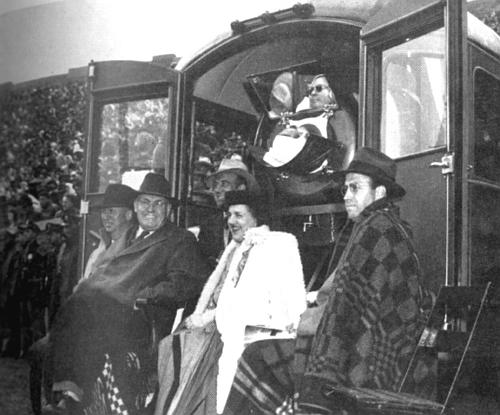
From the time the Notre Dame Grotto was dedicated, the most common expression of Notre Dame men’s devotion to Mary has been in their regular visits to the Grotto. The similarity of our own Grotto to the Lourdes Grotto has been captured in fine detail here at Notre Dame. In fact, there is even a stone from the Lourdes shrine in our own Grotto; it was brought back to Notre Dame by Father Maguire, who had visited Lourdes.(75)
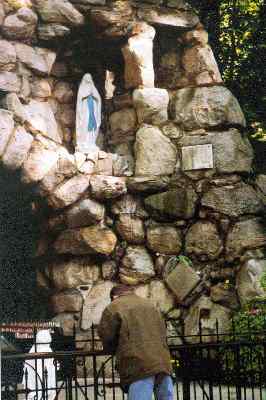 Even earlier, in 1942, the Scholastic reported the following information about additional relics donated to Notre Dame by Frederick Snite:
Even earlier, in 1942, the Scholastic reported the following information about additional relics donated to Notre Dame by Frederick Snite:
The Feast of Our Lady of Lourdes, which was celebrated last Wednesday, brings into the news the relics of St. Bernadette of Lourdes which are prize articles in the Museum atop the Notre Dame Library, now the Architectural Building.
Fred Snite, Jr., of Chicago, widely known victim of infantile paralysis, is the donor of the St. Bernadette of Lourdes mementos to the Notre Dame collection of relics. Mr. Snite acquired the pieces while on a visit to Lourdes two years ago, in 1939. Upon returning from Lourdes, he said that he had ‘received a greater grace than a cure from Our Lady.’
Chief among the Snite mementos is a New Year’s greeting in St. Bernadette’s own handwriting. The letter is dated January 1, 1859 and was written to Madam and Dr. Douze, friends of the young French girl. This is considered a second-class relic. In addition to the letter, the collection includes a small piece of rock from the niche in which the Blessed Virgin appeared to Bernadette, and a piece of wood from the Lourdes Grotto.
The family of Frederick Bernard Snite, Jr. donated the Snite Museum. Throughout the greater part of his life, Frederick was known as “The Man in the Iron Lung.” His story was told in the December 6, 1946 Scholastic :
On football weekends you would see Fred B. Snite in his house trailer-like vehicle parked on the sidelines. Through a specially built mirror attached to his iron lung, which he brought into the public limelight, he watched the game. Despite his handicap he followed the fortunes of the Fighting Irish, seeing all the Notre Dame home games he could and listening to away games by radio.
Fred Snite was the scion of a wealthy Chicago financier, who graduated from Notre Dame in the spring of 1933. Two years later he was ready to enter his father’s business, but to celebrate the event properly, the elder Snite took his family . . . on a world cruise. Snite was to enter the Chicago loan firm upon his return. But things didn’t work out that way; fate had smiled in another direction. In China, Fred Snite was suddenly taken ill while on a plane trip to Peiping. . . . Taken to a Peiping hospital after precious time had been lost and after a local physician had misdiagnosed his ailment, Snite was pronounced critically ill with the dreaded poliomyelitis, or infantile paralysis. Fortunately the only ‘iron lung’ in China was at that time in Peiping. Snite, unable to speak or breathe without artificial aid was placed in the lung, and little hope was held for his recovery.
However, the doctors didn’t reckon with Snite’s pluck. With splendid disregard for cynical predictions, Snite remained alive and within a few months he was not only talking again, but was speaking Chinese almost as fluently as a native. He never complained about his plight, but accepted it philosophically. In 1937, after his case had been making the headlines for a year, Snite was returned by boat to the United States. The following years he was again watching Notre Dame football . . . from a spot directly behind the goal posts.
Grantland Rice, the sports writer, rose to lyric heights in celebrating Rockne’s fighting backfield by proclaiming them the 4 Horseman, victors of the backfield. For his courage in battling his disease and his victory over his disabilities, Fred Snite was dubbed “The 5th Horseman.”
Condemned to spend a life of pain in a cumbersome Iron Lung, this Fifth Horseman of Notre Dame showed indomitable courage. His special trailer in which he traveled throughout the nation was a familiar sight at the north ramp of Notre Dame stadium at home games. He was indeed, one of Notre Dame’s all-time great competitors.
His own words from, The Man in the Iron Lung, expressed his philosophy:
“The faith that brought me peace also taught me that this life is a preparation for the next. In other words, I had a job to do like everyone else. I had not been left out.” -- Frederick Bernard Snite, Jr. in a prepared statement published in the Miami Herald, March 2, 1952.
. . . He did his job well. His story like that of thousands of other handicapped people, is a success story. If he ever sang the blues, nobody heard him not even those of us who were with him hourly, day after day. The public never saw him without a smile on his face, and those of us who were close to him can tell you that an hour rarely passed without a little joke on his lips.
. . . The man in the iron lung was no Superman. The radiant spirit that was to become his did not develop overnight. It was the product of a long struggle. [The words of] one of Frederick’s favorite nurses, and a devoted friend . . . echoed many of his former nurses . . . “as long as I live, the memory of Mr. Snite’s thoughtfulness will never die.”
One day Frederick mentioned Lourdes. . . . “If it’s God’s will that I be cured, I will be. If not, I won’t; obviously He has other plans for me. Whatever happens. I figure I have a right to ask only one thing: the strength to face up to it.”
Father Matthew Walsh speaks of Snite's Grotto experience at Lourdes:
“To Frederick at Lourdes,” says Father Walsh, “came, the miracle of resignation. Our Lady procured that for him beyond any doubt, and he never hesitated to give her credit for it. Fred had a good faith, of course, before he went to Lourdes. He had already reached a degree of resignation. But, as he used to point out, he never before had had the deep well of peace that was his the day he came up from the waters of piscine after the doctor and others tried to persuade him to keep out of the (piercingly cold) baths (he went in twice).
“After that . . . Frederick seemed to have the untroubled conviction that he would not be cured. In later years, he had the depth of resignation to tell me more than once that if God gave him the choice of getting well or staying in the lung, he would stay put.
“He sent out countless messages of cheer to sufferers all over the world.”(79)
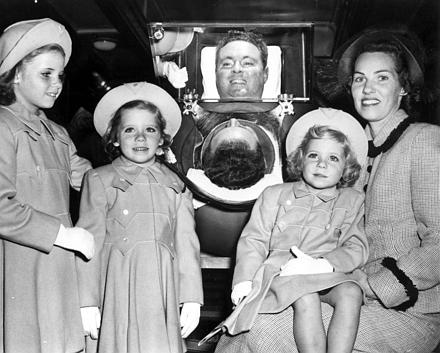
There was no room for self-pity or bitterness in his life which, apart from almost complete confinement in the respirator, was surprisingly normal. He married Teresa Larkin in 1939, and they had three daughters. . . He became a symbol of the triumph of spirit over the body.
The image of “The Boiler Kid” was frequently seen in newspapers, magazines, and newsreels nationwide. He published a newsletter entitled, appropriately, Back Talk, and his optimism encouraged countless other polio victims. . . . At his funeral in 1954, at the age of 44, he was mourned by many more than the 1,500 who came to say farewell to this remarkable, dauntless young man. [Excerpts from information circular “The Fred B. Snite Family,” Snite Museum of Art.]
Teresa Snite, Frederick’s wife, graciously supplied information about his Grotto experiences. She said there was no doubt that he had been inspired to go to Lourdes by the Notre Dame Grotto. In going there, she said, “he felt he had received a miracle of grace rather than a healing, a total acceptance that it was what God wanted him to do, that his respirator was his ticket to heaven.”
I knew from a previous mention in the Scholastic that the Bernadette letter was presented to Father Hesburgh in 1939 by Frederick Snite and after his death in 1954, Hesburgh presented it to Father Schaerf in 1958 in connection with the Lourdes Centenary. I can understand their wanting to bring back a tangible remembrance of Lourdes. I have had a fascination with stones all my life, and have collected them from little on up. Mainly because, no two are exactly alike. Like people, each one is unique and interesting. Which may also explain my avid interest in the Grotto from the first moment I saw it. The unhewn rocks used throughout it, some boulders weighing as much as 2 or 3 tons, lend that touch of warmth and irregularity found in nature to its wooded knoll. There is something about it that is very pleasing to the eye and the soul.
I never thought too much about this fascination until I read Man And His Symbols,(80) by Carl Jung, a book that caught my eye upon my last visit to the library. In it, I found these very interesting references to the symbolism of the stone in religion:
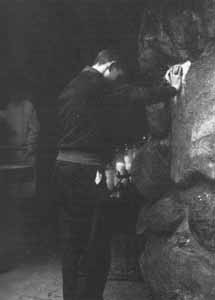
Biblical references to the ‘stone’ are numerous. ‘Christ is the stone that the builders rejected which became head of the corner’ (Luke XX:17). Christ is also called the spiritual rock from which the water of life springs (I Cor. X:4). Many religions use a stone to signify God or to mark a place of worship. The holiest sanctuary of the Islamic world is the Ka’abe, the black stone in Mecca to which all pious Moslems hope to make their pilgrimage.
Another reference to stones is also in the Bible: “Like living stones, let yourselves be built into a spiritual house . . .” 1 Peter 2:5. I related, most especially, to this comment Jung made:
Many people cannot refrain from picking up stones of a slightly unusual color or shape and keeping them, [as shells are picked up at the seashore], without knowing why they do. It is as if the stone held a mystery in it that fascinates them. Men have collected stones since the beginning of time and have apparently assumed that certain ones were the containers of the the spirit of the life-force with all its mystery.
The ancient Germans, for instance, believed that the spirits of the dead continued to live in their tombstones. The custom of placing stones on graves may spring partly from the symbolic idea that something eternal of the dead person remains which can be most fittingly represented by a stone.
In some cultures, when visiting a cemetery, a stone is placed on the grave in the belief that the dead loved one will know you have been there. The significance of the black stone at the Grotto, and my need to research its origin became clearer to me as I read on:
The stone symbolized something permanent that can never be lost or dissolved, something eternal that some have compared to the mystical experience of God within one’s own soul. It symbolizes what is perhaps the simplest and deepest experience, the experience of something eternal that man can have in those moments when he feels immortal and unalterable.
The Grotto at Notre Dame must inspire just such feelings in many people who visit there. As Tom Dooley described it, there is “something else” there, a special feeling, that is a different personal experience for each person drawn there by the spirit of the place.
In its own special way, it has transcended its historical origin -- becoming a praying place for all faiths. Even non churchgoers respond to its spiritual resonance. It has become a rich inspiration absorbing the spirits of all those who worked on it and worship in it. What has been said about books could also be said about the Grotto: Everyone brings something different to it and takes something different away. Visiting the Grotto is a uniquely personal experience. It is what has made it a cave of candles. My first visit there had the same effect upon me. The spirit of the place continues to call to me to do nothing less than my best in documenting the story behind it.
Recently, in the midst of editing this chapter an unexpected circumstance, in the form of a family crisis, interrupted my progress -- an unplanned but timely postscript was about to be added to this chapter about the black stones.
During a routine check-up, my husband was informed he would require immediate serious surgery. The outcome was uncertain. Like a bolt out of the blue our normal life was put on hold and my research project set aside indefinitely. Life seemed tenuous and uncertain. The day before surgery I found myself, once again, drawn to the Grotto to light a candle of hope.
It was Wednesday, we hadn’t thought about it being a big football weekend. The campus was crowded with no place to park. As we prepared to leave, a space opened up some distance away. We walked briskly through the chilly air to the Grotto. After we lit our candles, I moved toward the black stone, now special and familiar to me. On several other occasions in touching it, people had asked me about it. Many times since learning of it myself, and telling others about it, I have often wished that more people were aware of it.
As I approached it, a glint of gold sparkled in the sunshine. It caught my eye. I could hardly believe what I was seeing. The first plaque on the Grotto in almost 40 years. Above the black stone was a one inch by four inch tiny plaque. On it, were the simple words . . . “Stone From Lourdes France.” It had not been there two weeks before. “When God wants something done . . . He sends someone” was my immediate surprised and pleased response. Someone else must have wondered about it, too, and in learning what it was, decided that it should be marked for others. The black stone can be seen best in the picture at the beginning of this chapter. It is above the left shoulder of the student kneeling to pray.
For many years additional plaques have not been allowed at the Grotto. How it was accomplished only God knows, but I am most happy to see it there and I know many other visitors to the Grotto will feel the same way. Had I not been drawn there by the urge to light a candle during a family crisis, it might have been some time before I happened upon it. I know that I will never see that plaque or touch the Lourdes stone again without thinking of, and blessing, the person who arranged for it to be there.
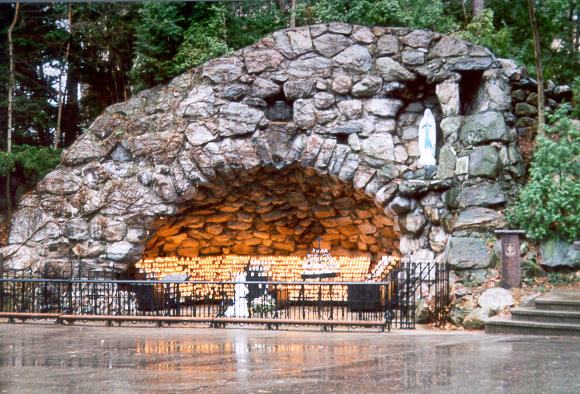
“A place of charm and enchantment for all seasons,
a pleasing artistic adaptation to its surroundings.”
-- Dorothy V. Corson
© 2001 by Robert F. Ringel.
All rights reserved.